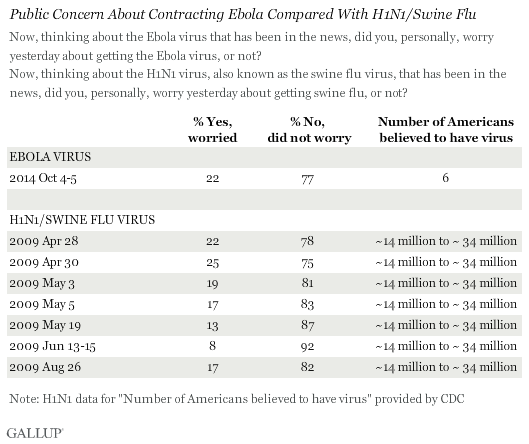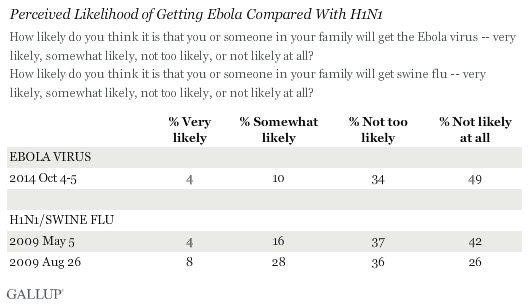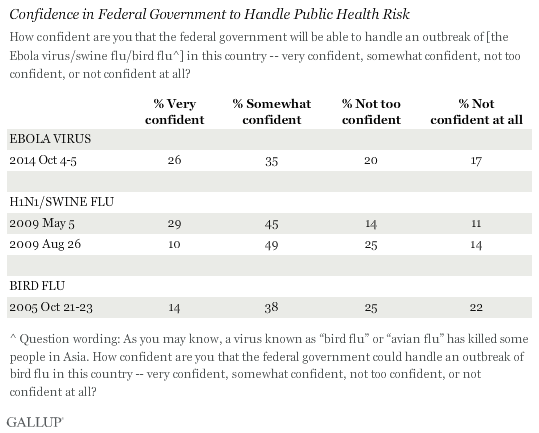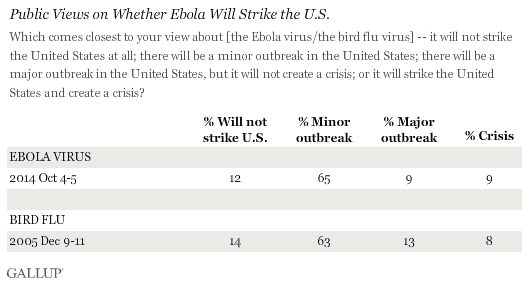WASHINGTON, D.C. -- Twenty-two percent of Americans say they worry about getting the Ebola virus, matching or exceeding the number of U.S. adults who worried about contracting the H1N1 virus throughout its 2009 outbreak, despite the higher prevalence of H1N1 in the U.S.

In total, six Americans are known to have contracted Ebola since the outbreak began this spring. All of these infections occurred in West Africa, the epicenter of the outbreak. By contrast, many more Americans contracted the H1N1 virus during the 2009 outbreak, though it is not as virulent as the deadly Ebola virus.
These results come from an Oct. 4-5 Gallup poll, conducted shortly after the first diagnosed case of Ebola in the U.S. -- a Liberian man staying in Texas -- was discovered. This poll was conducted prior to news reports of a Spanish woman becoming the first known case of a person to contract Ebola outside of Africa in the current outbreak, which could agitate public concerns further.
By and large, most Americans do not think it is likely that they or someone in their family will get the Ebola virus -- 34% deem it "not too likely," and 49% say "not likely at all." Four percent of Americans think it is very likely they will contract the Ebola virus, and another 10% consider it somewhat likely.

By comparison, Americans were similarly confident that they would escape the reach of the H1N1 flu when news of that virus started to mount in May 2009. One-fifth of U.S. adults at that time (20%) thought it was very or somewhat likely they would catch H1N1, the seasonal flu virus that received the sobriquet "swine flu" because it resembled viruses found in pigs. Nearly eight in 10 were not particularly concerned (79%). However, that figure fell to 62% by August.
Majority Have Confidence in Federal Government to Handle Outbreak
Americans have slightly less confidence in the federal government's ability to handle an outbreak of the Ebola virus in the U.S. (61%) than they did about its ability to contain the swine flu in May 2009 (74%). More specifically, 26% today are very confident the government can handle Ebola, and 35% are somewhat confident. However, confidence in the federal government's ability to handle the swine flu in 2009 did diminish as the outbreak progressed.

These ratings come amid allegations that a Dallas-area hospital released the Liberian man who had gone there with severe flu-like symptoms -- despite the hospital's awareness that he had recently traveled from Liberia. Although the hospital is private, the situation has raised questions about the government's oversight capabilities. As a result, pressure has amplified, including from Texas Gov. Rick Perry, for the federal government to enhance the screening process at all U.S. points of entry.
In stark contrast to the American public's reaction to Ebola and the swine flu is the 2005 scare involving the "avian" or "bird" flu, which never actually hit U.S. shores. In October 2005, 47% of Americans said they were "not too confident" or "not confident at all" in the government's ability to combat the bird flu. This widespread lack of confidence in the federal government may have been related the perception that the federal government poorly handled the response to Hurricane Katrina, which hit the Gulf coast in August of that year.
As has been seen in other public health scares, confidence in the federal government's abilities does vary with party affiliation. Today, with a Democrat serving as president, Democrats are more likely to have confidence in the federal government's ability to handle the Ebola virus (74% somewhat or very confident) than are Republicans (49%). In 2005, by contrast, with a Republican in the White House, self-identified GOP supporters were more likely to express confidence in the federal government's response capabilities than were Democrats.
Just 12% Say Ebola Will Not Strike U.S.
While there is no evidence that any person has contracted the Ebola virus while in the United States, Americans are not optimistic that the country will avoid a rendezvous with the disease in some form, although most do not expect a major outbreak. Just 12% say Ebola will not strike the U.S. Meanwhile, 65% say there will be a minor outbreak, and nearly a fifth say we will have either a major outbreak (9%) or a crisis (9%). These numbers are largely in line with public forecasts regarding the bird flu at the time, a disease that never materialized in the U.S.

Bottom Line
About as many Americans worry about contracting the Ebola virus today as worried about getting the H1N1 flu during the 2009 flu season. Of course, H1N1 was a more prevalent force in the U.S., both in terms of the number of Americans who contracted it and the fact that most were exposed in the U.S. But what Ebola lacks in sheer number of cases, it makes up for in its deadliness.
Survey Methods
Results for this Gallup poll are based on telephone interviews conducted Oct. 4-5, 2014, on the Gallup Daily tracking survey, with a random sample of 1,016 adults, aged 18 and older, living in all 50 U.S. states and the District of Columbia.
For results based on the total sample of national adults, the margin of sampling error is ±4 percentage points at the 95% confidence level.
Interviews are conducted with respondents on landline telephones and cellular phones, with interviews conducted in Spanish for respondents who are primarily Spanish-speaking. Each sample of national adults includes a minimum quota of 50% cellphone respondents and 50% landline respondents, with additional minimum quotas by time zone within region. Landline and cellular telephone numbers are selected using random-digit-dial methods. Landline respondents are chosen at random within each household on the basis of which member had the most recent birthday.
Samples are weighted to correct for unequal selection probability, nonresponse, and double coverage of landline and cell users in the two sampling frames. They are also weighted to match the national demographics of gender, age, race, Hispanic ethnicity, education, region, population density, and phone status (cellphone only/landline only/both, and cellphone mostly). Demographic weighting targets are based on the most recent Current Population Survey figures for the aged 18 and older U.S. population. Phone status targets are based on the most recent National Health Interview Survey. Population density targets are based on the most recent U.S. census. All reported margins of sampling error include the computed design effects for weighting.
In addition to sampling error, question wording and practical difficulties in conducting surveys can introduce error or bias into the findings of public opinion polls.
View survey methodology, complete question responses, and trends.
For more details on Gallup's polling methodology, visit www.gallup.com.
